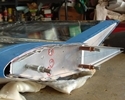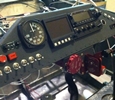


random user submitted photo
Bad Starter?
4 posts
• Page 1 of 1
Bad Starter?
A couple of weeks ago I went to the airport and my Onex would not start. I charged the battery overnight and the next day it started and I have flown it 3 or 4 times since. Today I went to the airport and it would not start again. It cranked a couple of turns and then it would just click. The battery is only two years old. So I pulled my RV-12 out of the hangar and flew it for about an hour. I put the airplanes back in the hangar and put the battery charger on the Onex battery. Within 30 minutes the charger showed the battery was fully charged. I was out of time so I went home without trying to start it. Now I am wondering if the problem might be the starter and not the battery. For the battery to be so low that it will only turn the prop a couple of turns would make me think it would take several hours to fully charge it. I looked at the price of the starter on the Sonex site and was shocked, $575.00.
How can I tell if the problem is the battery or the starter?
Thanks.
John
How can I tell if the problem is the battery or the starter?
Thanks.
John
- pilotyoung
- Posts: 188
- Joined: Fri Jun 07, 2019 7:31 am
Re: Bad Starter?
First try another battery.
What kind of battery doe you have? The EarthX has battery management that shuts it off if too much voltage drop or too high cranking amps.
What kind of battery doe you have? The EarthX has battery management that shuts it off if too much voltage drop or too high cranking amps.
Alex
Flying:
Sonex Legacy TD PH-AWX Aerovee https://www.facebook.com/SonexPHAWX/
RV-7A PH-PWP
Building:
Piel CP1320 https://eaabuilderslog.org/?s=CP1320
Flying:
Sonex Legacy TD PH-AWX Aerovee https://www.facebook.com/SonexPHAWX/
RV-7A PH-PWP
Building:
Piel CP1320 https://eaabuilderslog.org/?s=CP1320
- AlexZ
- Posts: 51
- Joined: Fri May 27, 2016 8:06 am
Re: Bad Starter?
pilotyoung wrote:How can I tell if the problem is the battery or the starter?
Classic symptoms of first colder weather start of the season which is quick to show battery weaknesses. The engine is inherently harder to start with colder and thicker oil, the starter draws more amps, the older battery fails to provide. And is quickly depleted. You have often been "getting away with it" through the warmer summer - but as soon as there is any real demand on the system - it shows its weakness.
Add to that any slightly grungy contacts or loose leads in the heavy duty cables and things also just got harder.
If you have the stock lead acid battery - just try jump starting the plane with a decent set of heavy duty long jump leads, plane well tied down and the vehicle safely positioned. If it starts and runs normally - it's almost certainly not the starter.
Add to that the fact it did turn over but then reverted to just "click". That's almost certainly the click of the starter solenoid which only takes a half amp to switch the heavy duty leads - but with no real current left from the battery - the starter doesn't turn,
--
So go through the heavy duty battery/starter/ground wiring and make sure that the contact surfaces are completely clean and bright, apply some dielectric contact grease and tighten everything down correctly.
The number of duty cycles of those small lead acid batteries is rather low. As few as 200 cycles and less if not kept maintained at good charge throughout its life. You report it charged quickly but failed to start the engine - that is actually pretty classic for a failing lead acid battery - it quickly develops a high "float" voltage but there is no real depth or capacity to the charge and it fails to deliver any meaningful current.
You can take the battery and get it load tested - basically it is charged and a heavy load is applied and measured to see if it is still able to deliver current. I'm betting it won't.
If contemplating a new battery - ask your friendly NAPA tech for the jetski equivalent. It is much cheaper, dimensionally can be made to work in the stock battery box and as well/less well made as the stock recommendation.
Or switch to EarthX.
--
If you HAVE an EarthX - then most of this is still valid - at least from a testing viewpoint - but you should not jump start with an EarthX in the system. Instead put in any small lead acid motorcycle battery you can borrow to provide the load and circuit. That will at least let you confirm it is not the starter.
I would be interested if you have an EarthX and it turns out it has failed. They are supposed to be good for up to 2000 duty cycles. And while I have fitted one- I remain concerned about the heat under the cowl being detrimental to the long term life of the battery. Next time I have nothing to do I might well move it into the cabin to get away from the heat. If EarthX - how many cycles do you think you got from it?
--
The best thing you can do to be sure of good starts is to keep your battery maintained. A long taxi after landing with everything still on and you are depleting the battery as the slow turning alternator can't keep up. Some folks are in the habit of turning everything off including the second mag to maintain the battery during the taxi in.
I do a blend of this and have a battery minder on the plane whenever it is not flying. I'm in the tie downs and constructed a solar charge maintainer to do this. Even in the depths of winter - if the engine is properly preheated - the engine starts fine.
Graeme JW Smith
-

GraemeSmith - Posts: 939
- Joined: Sat May 18, 2019 8:58 am
- Location: RI
Re: Bad Starter?
It is not an EarthX battery. I think it is an Oddesy. I am going to take it out and get it tested at an auto parts store. Thanks for your comments.
- pilotyoung
- Posts: 188
- Joined: Fri Jun 07, 2019 7:31 am
4 posts
• Page 1 of 1
Who is online
Users browsing this forum: No registered users and 58 guests







